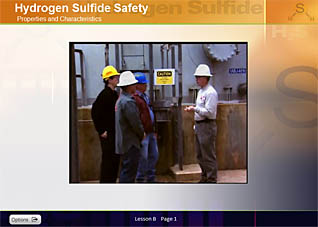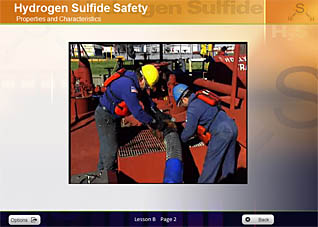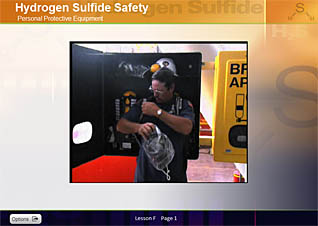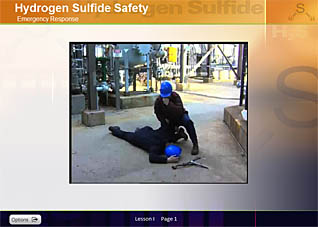Hydrogen Sulfide - H2S - Safety

- Product ID
- moxih2ss_htm
- Training Time ?
- 75 to 105 minutes
- Language(s)
- English
- Video Format
- Standard Definition
- Required Plugins
- None
- Number of Lessons
- 10
- Quiz Questions
- 29
- Question Feedback
- Wrong Answer Remediation
- Lesson Bookmarking
- Downloadable Resources



Hydrogen sulfide is a deadly substance, and can be found in many workplaces. Understanding and controlling the hazards hydrogen sulfide presents can be a matter of life and death; it is vital you know the risks and how to reduce the likelihood of being harmed.
Use this online training to learn what hydrogen sulfide is, how to work safely with it, the proper PPE to wear, as well as other critical pieces of information necessary to avoid injury to yourself and your coworkers. In addition to detection devices, this course also covers safe work practices and what to do in an emergency response situation.
Hydrogen sulfide can be very dangerous; in fact if the concentration is high enough it can cause death in a matter of minutes. Understanding the material presented here gives you the information needed to understand what hydrogen sulfide is, how you may encounter it, how to protect yourself from it, and what to do should you or a coworker be exposed to it. Follow this training and create a more aware, and safer, workplace.

- Install on any SCORM LMS
- Rich multimedia presentation with interactions and quiz
- Print certificate and wallet card
- You have 30 days to complete the course
Anyone working in the oilfield or petrochemical industry
-
What is Hydrogen Sulfide?
- Scientific names
- Common names
-
Properties and Characteristics
- Parts per million
- Exposure limits
-
Working Safely with Hydrogen Sulfide
- Six action steps
-
Contingency Plans
- Essential and non-essential workers
-
Engineering Controls
- Containment
- Ventilation
-
Personal Protective Equipment
- Self-contained breathing apparatus
- Escape unit
- 30 minute work/rescue unit
-
Detection
- Three types of gas detection equipment
-
Safe Work Practices
- Buddy system
-
Emergency Response
- Emergency plan
- Conclusion
-
Recognize Hydrogen Sulfide.
- List common scientific names for Hydrogen Sulfide.
- Locate areas where Hydrogen Sulfide is commonly found.
-
Refer to Hydrogen Sulfide properties and characteristics for safe use.
- Choose the concentration at which H2S is considered unhealthy.
- List possible outcomes of short term exposure to Hydrogen Sulfide.
- State what concentration of Hydrogen Sulfide could result in death.
- List factors that could make someone more susceptible to H2S.
- Recall that there are no visual warning signs of Hydrogen Sulfide.
- Explain the properties of Hydrogen Sulfide when mixed with air.
-
Work safely with Hydrogen Sulfide.
- List the six action steps required to work safely with H2S.
-
Have a contingency plan in place when working with Hydrogen Sulfide.
- List parts of a contingency plan.
- Select the designated roles stated in a contingency plan.
- Describe essential personnel duties.
-
Use engineering controls when working with Hydrogen Sulfide.
- Choose equipment or system engineering controls.
- Recall the need to stay upwind of Hydrogen Sulfide.
-
Use the proper Personal Protective Equipment when working with H2S.
- Determine the level of H2S when respiratory protection is required
- Recognize the proper type of respirator used with Hydrogen Sulfide
- State the use of an Escape unit.
- Choose the respiratory protection used for prolonged work in H2S.
- Determine the amount of breathing time provided in an SCBA tank.
- Explain steps to take when a SCBA alarm sounds.
-
Detect Hydrogen Sulfide in the air.
- List Gas detection equipment used to detect Hydrogen Sulfide.
- Know the color of the indicator when lead acetate tapes indicate H2S.
- Explain what to do when an alarm sounds.
- Agree that safe work practices must be used with gas detectors.
-
Follow safe work practices when working with Hydrogen Sulfide.
- Describe the reason for a buddy system.
-
Follow an emergency plan.
- List topics an emergency plan should include.
- Explain why an emergency response plan is necessary.
- List steps to take before attempting an emergency rescue.
© Mastery Technologies, Inc.



